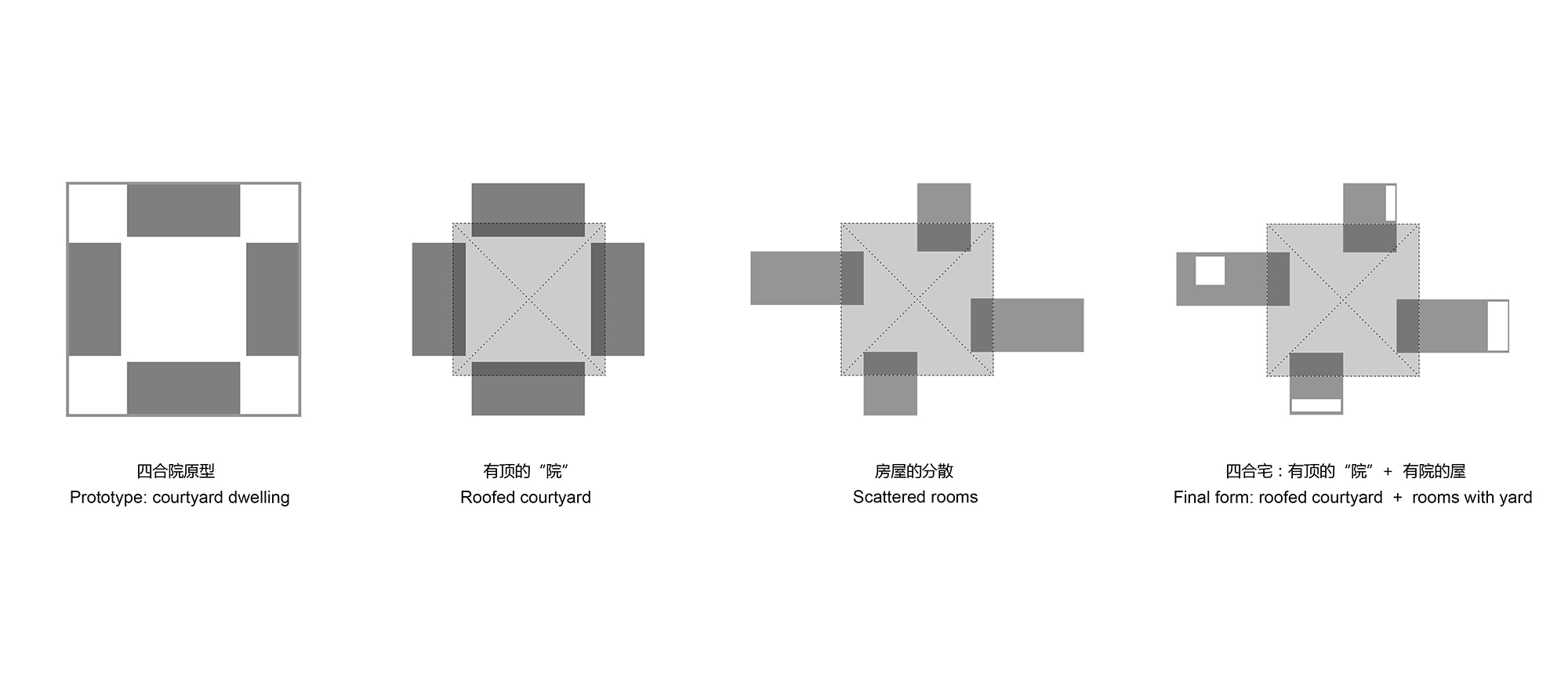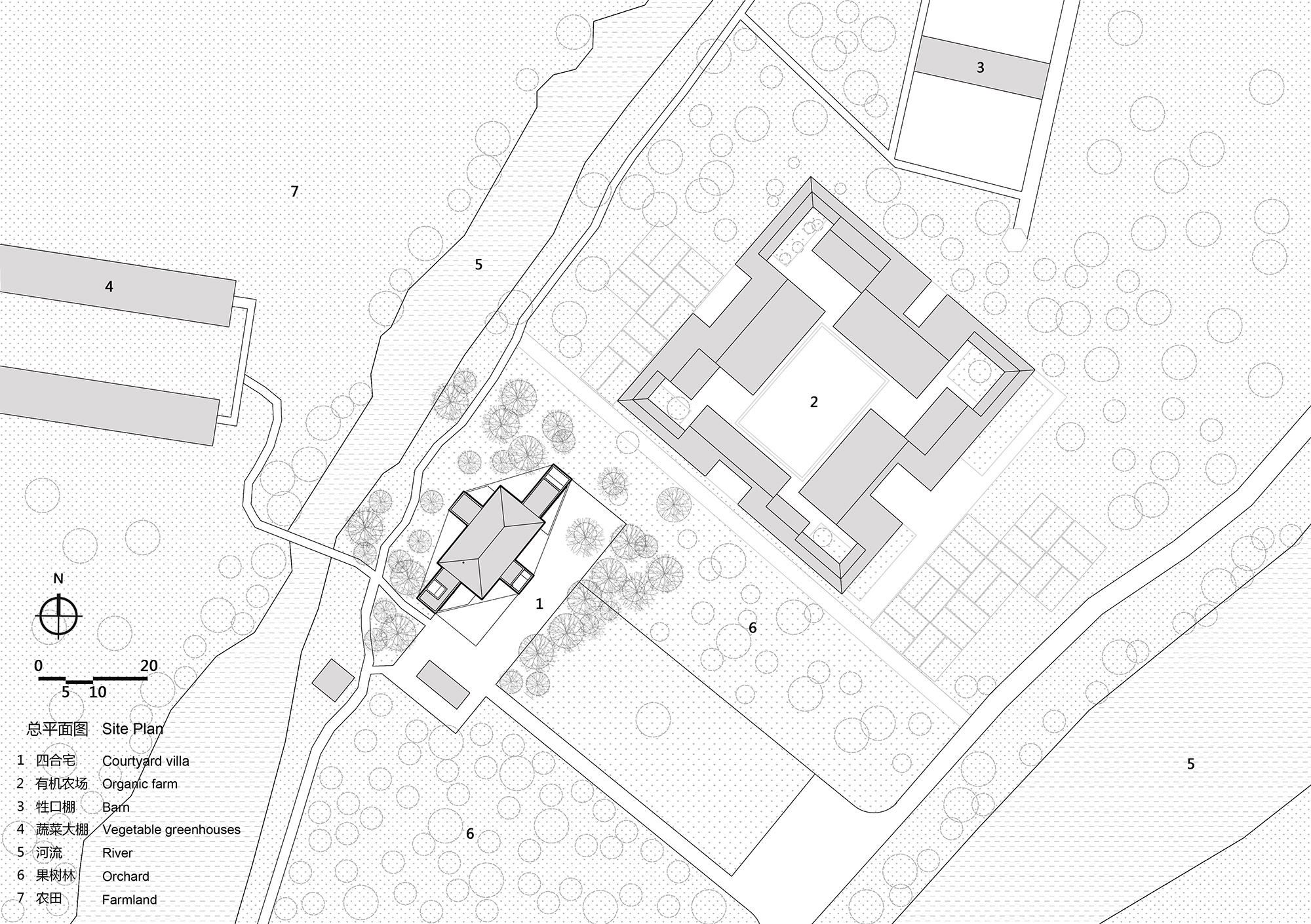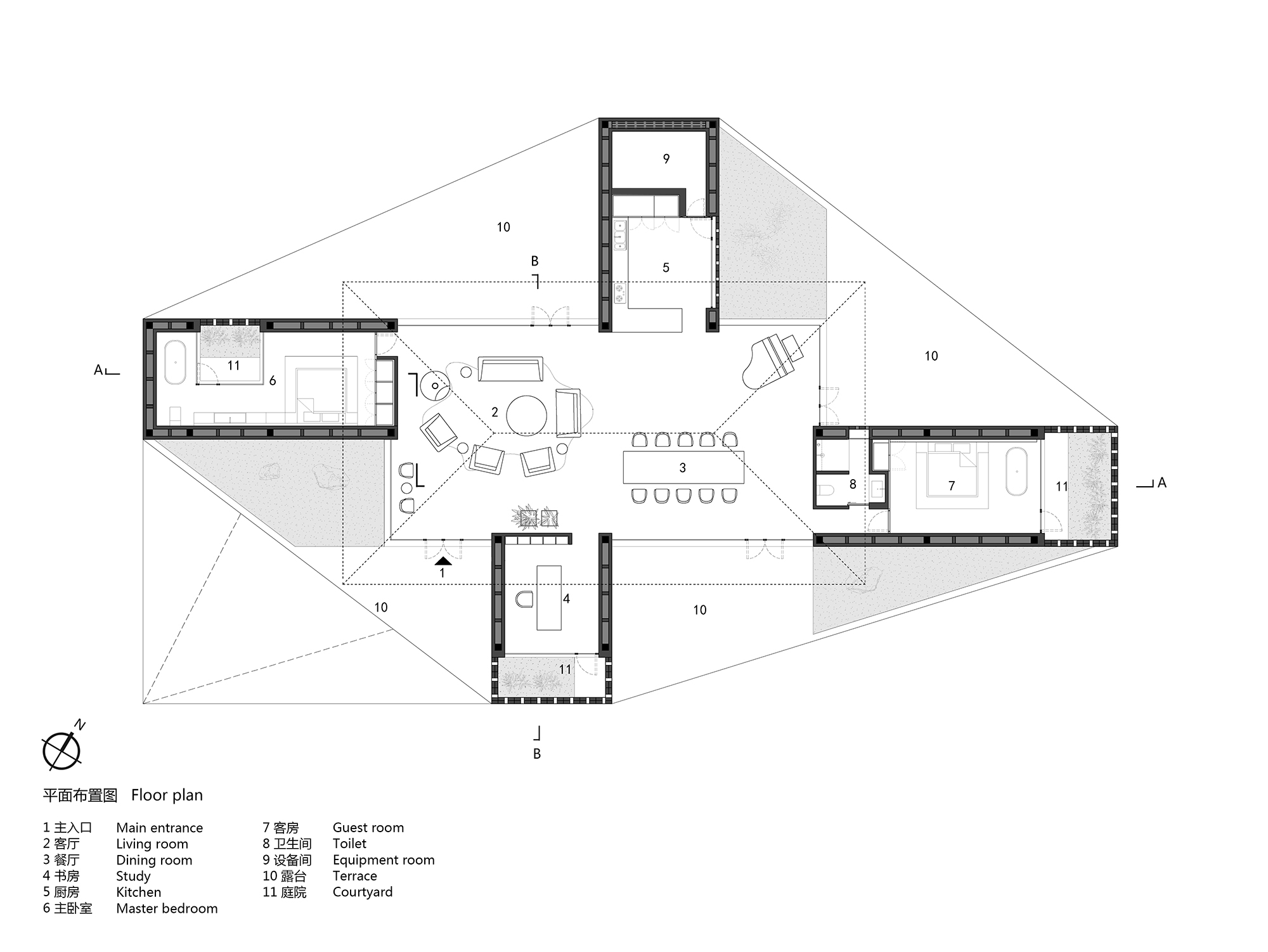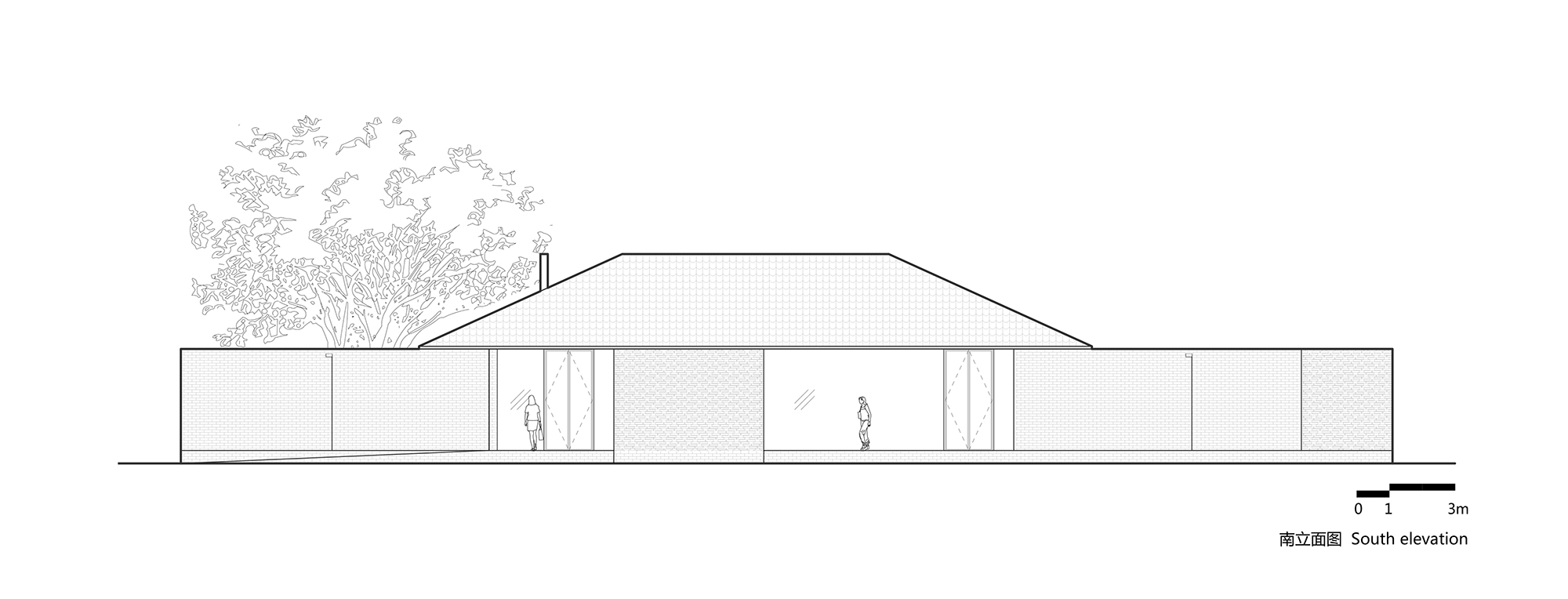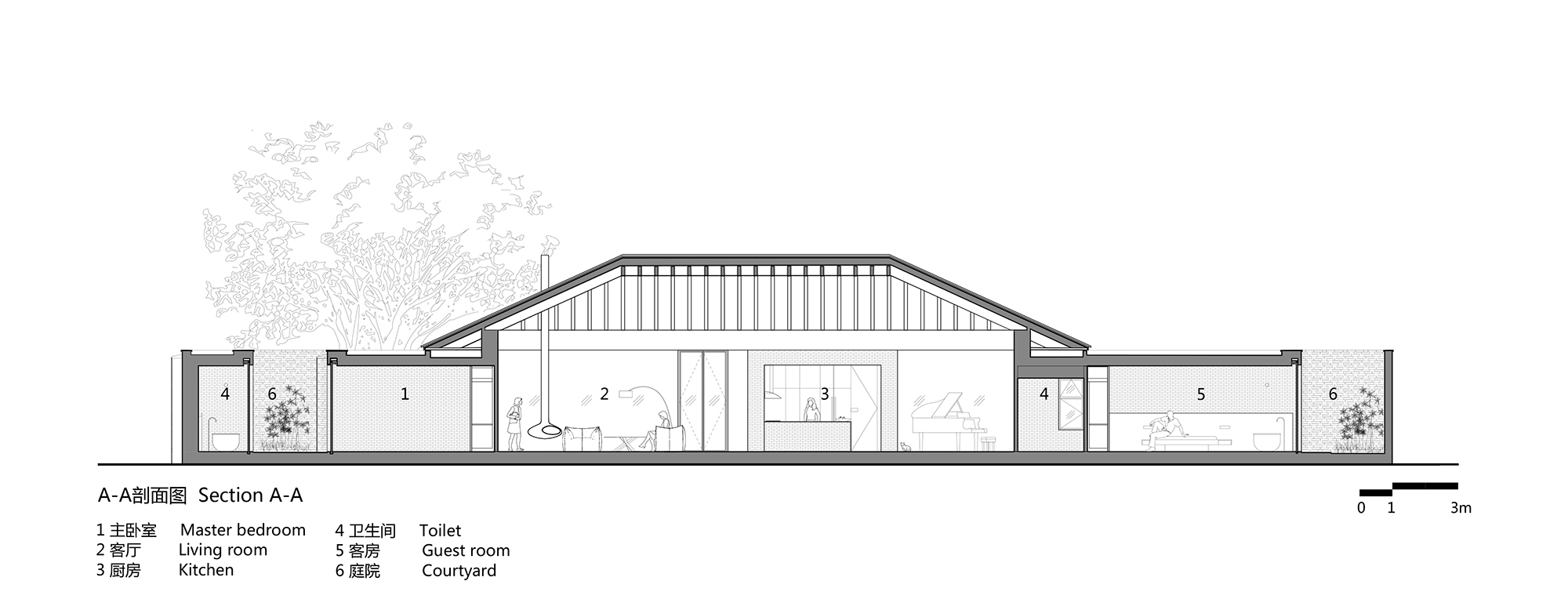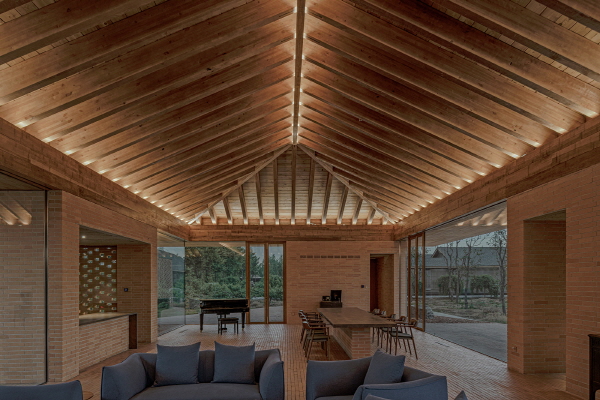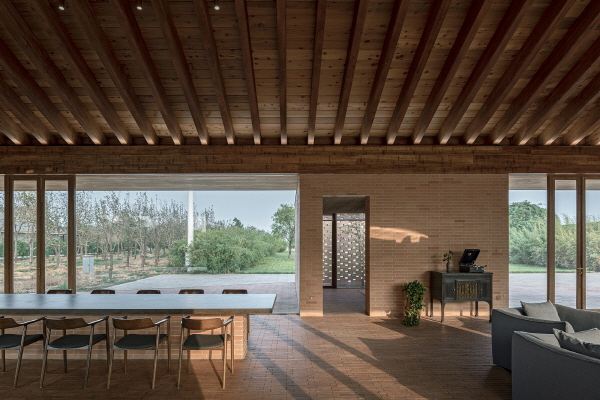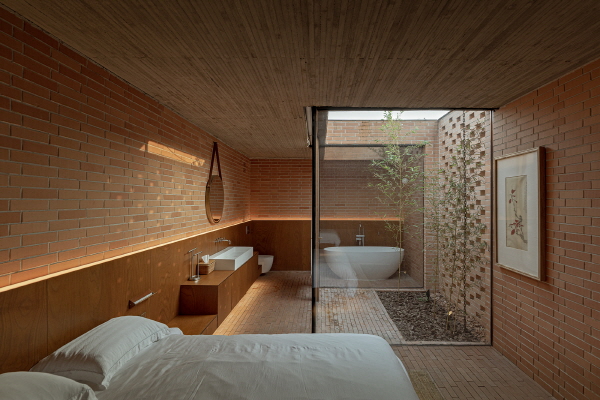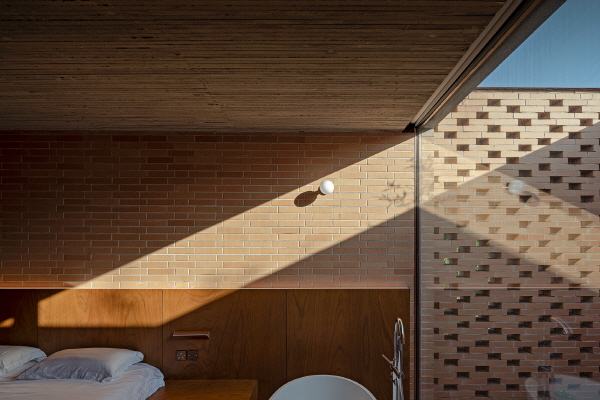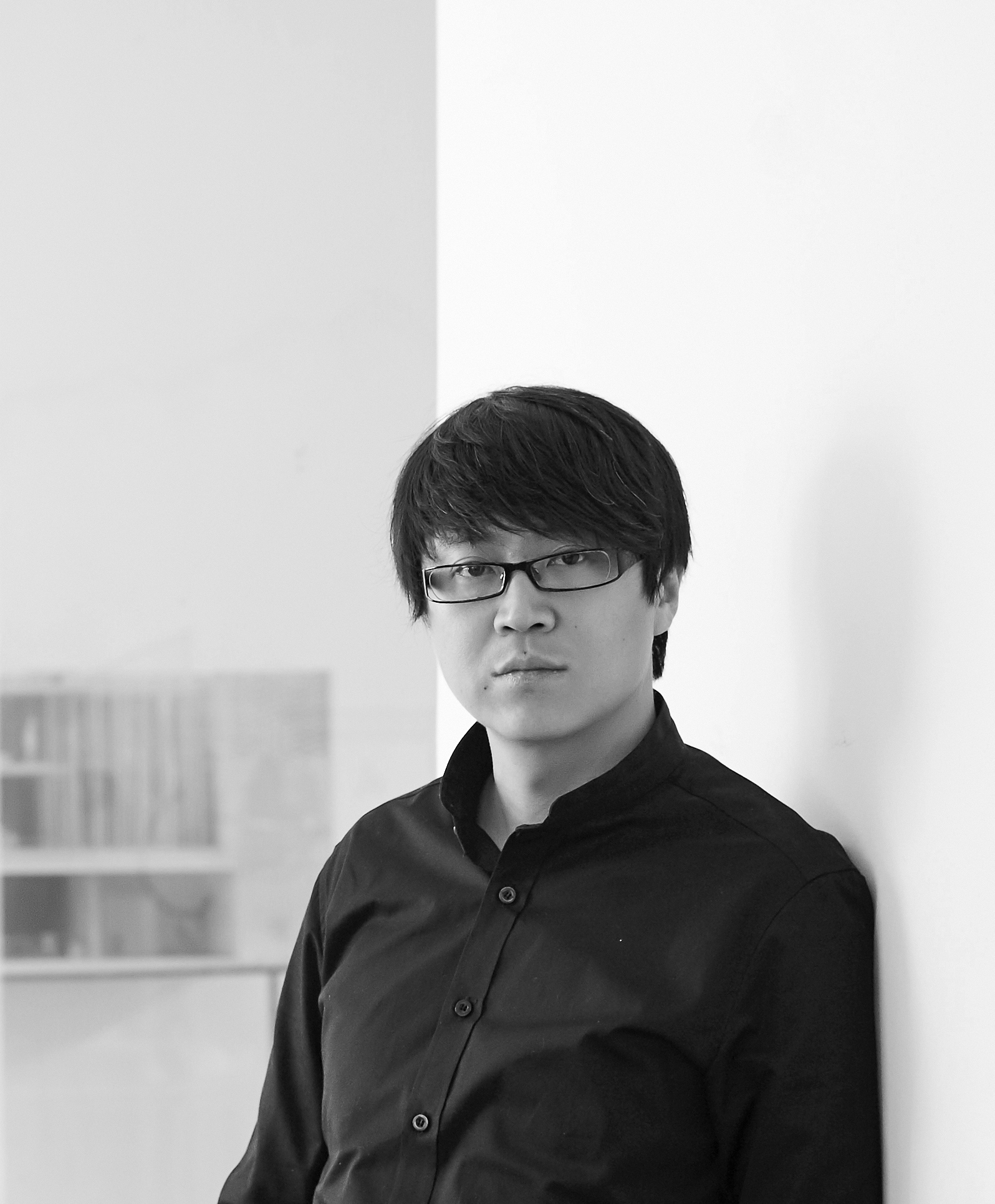AD
●● 멋진 세상 속 건축디자인_ 중국 허베이성 탕산 코트야드 빌라(Courtyard Villa), Architectural form derived from traditional Chinese courtyard dwellings… 중정을 가운데 두고 4개의 서로 다른 방향성을 지닌 공간의 절묘한 배치가 돋보여
The project is situated on a flat site in the suburbs, which is surrounded by orchards, farmland and rivers, boasting beautiful landscape. On the west side is a grain processing factory, which is an enclosed architecture with pitched roofs designed by ARCHSTUDIO in previous years. There was originally a wooden house on the site, with a typical structure commonly seen a decade ago. To improve the quality of space, the house owner decided to demolish it and build a new architecture on the site. The newly built house mainly functions as a leisure and vacation space, serving for not only living but also receiving guests.
The design concept is derived from courtyard dwellings (Siheyuan), a kind of traditional Chinese residence. Siheyuan has an inward-facing architectural structure, with buildings arranged around a central courtyard. The exterior of Siheyuan is closed, while the interior courtyard is completely open, which offers little privacy for the occupants. Based on site conditions and the main functions of the project, ARCHSTUDIO decided to construct the house by borrowing and transforming the architectural pattern of traditional Siheyuan. The design team arranged four rooms on different sides in a scattered way, added a roof to the "courtyard" and turned it into a hall, and made the exteriors of the hall transparent and open, thereby letting the hall blend with the pleasant outdoor scenery, and ensuring the privacy of individual living spaces and openness for reception activities.
The entire architecture is based on the pedestal, with the four rooms independently set on four corners, together outlining the boundary of the house. The four rooms are all inward-facing, and each of them contains a yard inside. With different scales, those yards bring landscape and natural light into the interior. The house consists of private living areas and service spaces, including bedrooms, study, kitchen, and equipment room, all of which are separate from one another to avoid interference. The four rooms jointly support a pitch roof, under which is a flexible public area for accommodating various activities such as reception, dining and piano playing. Thanks to transparent glass windows and doors, public activities can be extended to the outdoor terraces on four sides, where people can enjoy the refreshing greenery.
ARCHSTUDIO well handled the relationship among space, structure and materials, and tried to present the natural beauty of materials based on the characteristics of rural leisure space. The four rooms use steel framework and concrete slabs, with the wooden formwork of the in-situ concrete slabs exposed in the interior spaces. Beige shale bricks were utilized to construct the walls. The walls are composed of two vertical layers of bricks, with a thermal insulation layer in between, which improves the thermal performance, ensures identical material texture of the interior and exterior brick walls, and hides framework as well as pipes and wires of equipment. In the inner yards, large areas of the brick walls leave hollows, hence allowing natural air ventilation and light penetration. Pedestal surfaces, either inside or outside, are also paved with beige bricks. The pitched roof of the public area adopts wooden ribbed beams, with the rooftop clad in charred wood tiles. The combination of wood and bricks produces an austere, warm and natural interior ambience. In addition, the fireplace, dining table and piano further identify different public activity areas.
빌라 전체를 치장하고 있는 점토 벽돌은 자연과 잘 조화를 이루고 있다. 이처럼 코트야드 빌라는 전원에 들어선 대지 특성을 효과적으로 활용하고 중정을 활용한 안정적이면서도 개방적인 배치로 거주공간의 프라이버시는 물론 개방성을 극대화하고 있다. >>Han Wenqiang_ Chief designer, Jiang Zhao, Hu Bo_ Architectural & interior design, 자료_ ARCHSTUDIO, Photos by Wang Ning, 기사 출처_ 에이앤뉴스 건축디자인건설경제미디어뉴스 AN NEWS(ANN NEWS CENTER) 제공
안정원(비비안안 Vivian AN) 에이앤뉴스 발행인 겸 대표이사, 한양대학교 실내건축디자인학과 겸임교수, 한양대학교 IAB자문교수
기사 제공_ 에이앤뉴스그룹(에이앤뉴스 AN NEWS_건축디자인건설경제미디어뉴스‧ANN TV_건축디자인뉴스채널‧에이앤프레스_건설지전문출판사)
>>Han Wenqiang Associate Professor, School of Architecture of CAFA (Central Academy of Fine Arts), Founder & Chief Architect, ARCHSTUDIO. Han Wenqiang was born in Dalian, Liaoning, China. He got a master’s degree in School of Architecture of CAFA in 2005 and since then has been teaching there. In his design practices and researches, he advocates observing and reflecting on physical environment with traditional wisdom, insists on a basic view that “space is a medium”, takes “design of relationships” as an important approach, creates forms based on physical objects, produces spatial ambience for the mind, and strives to achieve harmony and balance among human, nature, history, culture, commerce and space. His representative works mainly include Waterside Buddhist Shrine, Tea House in Hutong, Organic Farm, Twisting Courtyard, etc. He was a winner of Architectural Record’s Design Vanguard Competition in 2015 and Perspective’s 40 UNDER 40 Awards (Architecture category) in 2017. Besides, he has been included in the AD100 list consecutively from 2015 to 2019, which recognizes him as China’s top 100 talents in architecture and design.
[저작권자(c) YTN 무단전재, 재배포 및 AI 데이터 활용 금지]
The project is situated on a flat site in the suburbs, which is surrounded by orchards, farmland and rivers, boasting beautiful landscape. On the west side is a grain processing factory, which is an enclosed architecture with pitched roofs designed by ARCHSTUDIO in previous years. There was originally a wooden house on the site, with a typical structure commonly seen a decade ago. To improve the quality of space, the house owner decided to demolish it and build a new architecture on the site. The newly built house mainly functions as a leisure and vacation space, serving for not only living but also receiving guests.
The design concept is derived from courtyard dwellings (Siheyuan), a kind of traditional Chinese residence. Siheyuan has an inward-facing architectural structure, with buildings arranged around a central courtyard. The exterior of Siheyuan is closed, while the interior courtyard is completely open, which offers little privacy for the occupants. Based on site conditions and the main functions of the project, ARCHSTUDIO decided to construct the house by borrowing and transforming the architectural pattern of traditional Siheyuan. The design team arranged four rooms on different sides in a scattered way, added a roof to the "courtyard" and turned it into a hall, and made the exteriors of the hall transparent and open, thereby letting the hall blend with the pleasant outdoor scenery, and ensuring the privacy of individual living spaces and openness for reception activities.
The entire architecture is based on the pedestal, with the four rooms independently set on four corners, together outlining the boundary of the house. The four rooms are all inward-facing, and each of them contains a yard inside. With different scales, those yards bring landscape and natural light into the interior. The house consists of private living areas and service spaces, including bedrooms, study, kitchen, and equipment room, all of which are separate from one another to avoid interference. The four rooms jointly support a pitch roof, under which is a flexible public area for accommodating various activities such as reception, dining and piano playing. Thanks to transparent glass windows and doors, public activities can be extended to the outdoor terraces on four sides, where people can enjoy the refreshing greenery.
ARCHSTUDIO well handled the relationship among space, structure and materials, and tried to present the natural beauty of materials based on the characteristics of rural leisure space. The four rooms use steel framework and concrete slabs, with the wooden formwork of the in-situ concrete slabs exposed in the interior spaces. Beige shale bricks were utilized to construct the walls. The walls are composed of two vertical layers of bricks, with a thermal insulation layer in between, which improves the thermal performance, ensures identical material texture of the interior and exterior brick walls, and hides framework as well as pipes and wires of equipment. In the inner yards, large areas of the brick walls leave hollows, hence allowing natural air ventilation and light penetration. Pedestal surfaces, either inside or outside, are also paved with beige bricks. The pitched roof of the public area adopts wooden ribbed beams, with the rooftop clad in charred wood tiles. The combination of wood and bricks produces an austere, warm and natural interior ambience. In addition, the fireplace, dining table and piano further identify different public activity areas.
빌라 전체를 치장하고 있는 점토 벽돌은 자연과 잘 조화를 이루고 있다. 이처럼 코트야드 빌라는 전원에 들어선 대지 특성을 효과적으로 활용하고 중정을 활용한 안정적이면서도 개방적인 배치로 거주공간의 프라이버시는 물론 개방성을 극대화하고 있다. >>Han Wenqiang_ Chief designer, Jiang Zhao, Hu Bo_ Architectural & interior design, 자료_ ARCHSTUDIO, Photos by Wang Ning, 기사 출처_ 에이앤뉴스 건축디자인건설경제미디어뉴스 AN NEWS(ANN NEWS CENTER) 제공
안정원(비비안안 Vivian AN) 에이앤뉴스 발행인 겸 대표이사, 한양대학교 실내건축디자인학과 겸임교수, 한양대학교 IAB자문교수
기사 제공_ 에이앤뉴스그룹(에이앤뉴스 AN NEWS_건축디자인건설경제미디어뉴스‧ANN TV_건축디자인뉴스채널‧에이앤프레스_건설지전문출판사)
>>Han Wenqiang Associate Professor, School of Architecture of CAFA (Central Academy of Fine Arts), Founder & Chief Architect, ARCHSTUDIO. Han Wenqiang was born in Dalian, Liaoning, China. He got a master’s degree in School of Architecture of CAFA in 2005 and since then has been teaching there. In his design practices and researches, he advocates observing and reflecting on physical environment with traditional wisdom, insists on a basic view that “space is a medium”, takes “design of relationships” as an important approach, creates forms based on physical objects, produces spatial ambience for the mind, and strives to achieve harmony and balance among human, nature, history, culture, commerce and space. His representative works mainly include Waterside Buddhist Shrine, Tea House in Hutong, Organic Farm, Twisting Courtyard, etc. He was a winner of Architectural Record’s Design Vanguard Competition in 2015 and Perspective’s 40 UNDER 40 Awards (Architecture category) in 2017. Besides, he has been included in the AD100 list consecutively from 2015 to 2019, which recognizes him as China’s top 100 talents in architecture and design.
[저작권자(c) YTN 무단전재, 재배포 및 AI 데이터 활용 금지]
